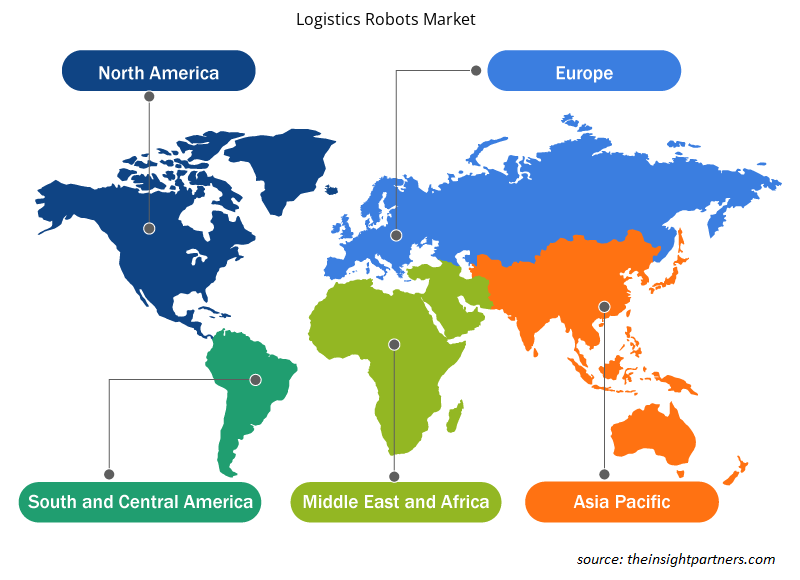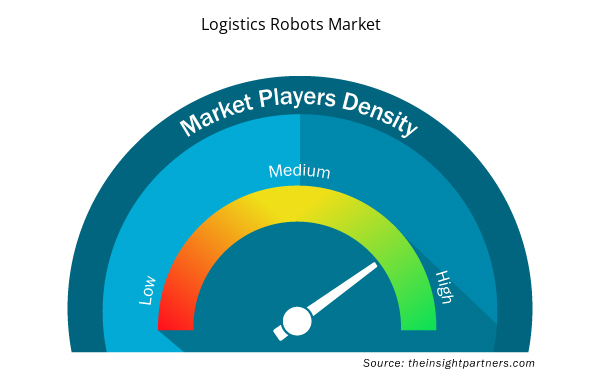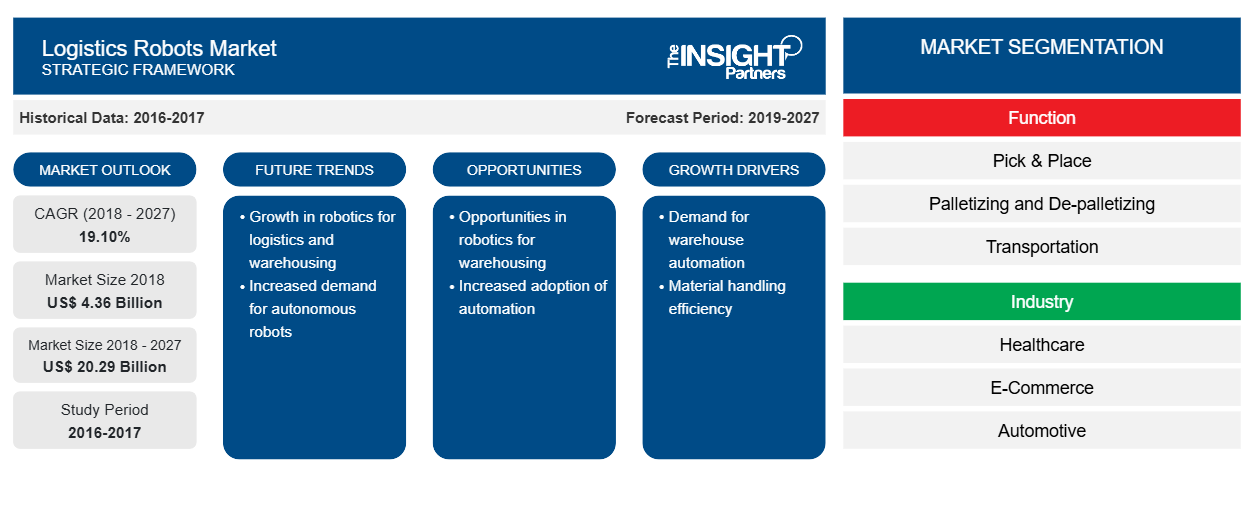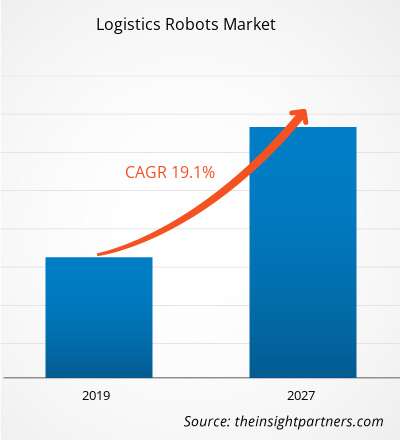2018 年物流机器人市场价值为 43.562 亿美元,预计 2019 年至 2027 年的复合年增长率为 19.10%,到 2027 年达到 202.934 亿美元。
越来越多的物流和仓储公司开始大力推广使用机器人,以提高效率、速度和增加利润,从而保持市场竞争力。为了以可承受的价格提高运营效率,公司越来越多地采用机器人仓储和物流技术等先进技术。全球物流机器人市场的发展受到全球老龄化人口比例不断上升导致劳动力短缺和全球供应链网络不断扩大等因素的驱动,但预计在预测期内,部署物流机器人的高额资本投资将抑制物流机器人市场的增长。然而,亚太地区和欧洲国家不断增长的仓库自动化和成熟的市场可能会在不久的将来为行业参与者带来巨大的增长机会,以提高市场份额。
市场洞察
全球老龄人口比例上升导致劳动力短缺
全球老龄人口比例的不断增长是各行业劳动力减少的主要因素之一。世界各国都见证着社区老年人口数量的激增。人口老龄化已成为 21 世纪社会转型的重要因素之一,涉及劳动力和金融市场。不过,意大利、日本等许多国家是老龄人口比例最高的国家,65 岁以上的人口占总人口的很大比例。据世界卫生组织称,到 2050 年,全球 60 岁以上的人口预计将达到约 200 万人,是 2000 年的三倍。老龄人口数量的激增是劳动力短缺的原因。在多个行业中实施物流机器人发挥着重要作用,因为它可以降低流程的总体成本、提高生产率、增强安全性并减少人为错误。全球仓库技术的快速进步,重点关注与供应链流程所面临的困难相关的需求,并确保所使用的技术与业务目标相关。在产品生命周期的不同单元、功能和阶段中实施机器人是当今仓库在其增长道路上面临的主要挑战,这反过来又会在不久的将来推动物流机器人市场的发展。
定制此报告以满足您的需求
您可以免费定制任何报告,包括本报告的部分内容、国家级分析、Excel 数据包,以及为初创企业和大学提供优惠和折扣
- 获取此报告的关键市场趋势。这个免费样品将包括数据分析,从市场趋势到估计和预测。
机器人类型洞察
协作移动机器人在全球物流机器人市场中占据最大份额。它们被部署到各个行业,执行包装、机器操作和物料搬运等多项任务,因为这些协作机器人足够熟练,可以处理重型和轻型操作。它们非常准确、灵活和精确。此外,协作机器人易于维护,更易于重新配置和重新编程。这些机器人还可以处理敏感工作;此外,它们会根据制造过程中出现的不一致情况进行自我调整。协作机器人能够收集关键指标,以提供机载分析和报告,从而简化决策过程,推动整个物流机器人市场的发展。
功能洞察
运输部门占据了全球物流机器人市场的最大份额。货物被码垛起来,产品的形状和尺寸略有不同,因此需要自动化来装卸这些货物。3D激光视觉与新的机器人软件集成在一起,可帮助用户查看集装箱中的不同产品,确定理想的装卸顺序,并以高精度执行该过程。物流机器人用于移动目标架、拉起和抬起篮子、在货架上伸展叉子以及返回目标位置,推动整个物流机器人市场的发展。
行业洞察
外包物流部门占据了全球物流机器人市场的最大份额。这些物流服务提供商提供各种服务,包括仓储、库存管理、运输、配送、订单履行和货运整合。对及时交付管理以及降低运输成本的需求不断增长,增强了对保持库存材料记录的关注,以及核心业务和公司资产的减少,预计将在预测期内推动物流机器人市场的发展。
公司通常会采用多种市场主动策略来扩大其全球业务范围并满足不断增长的需求。这种策略主要在欧洲和亚太地区实施。物流机器人市场的参与者采用扩张和投资研发的策略来扩大全球客户群,这也使参与者能够在全球范围内保持其品牌名称。
物流机器人市场区域洞察
Insight Partners 的分析师详细解释了预测期内影响物流机器人市场的区域趋势和因素。本节还讨论了北美、欧洲、亚太地区、中东和非洲以及南美和中美洲的物流机器人市场细分和地理位置。

- 获取物流机器人市场的区域特定数据
物流机器人市场报告范围
| 报告属性 | 细节 |
|---|---|
| 2018 年市场规模 | 43.6亿美元 |
| 2027 年市场规模 | 202.9亿美元 |
| 全球复合年增长率(2018 - 2027) | 19.10% |
| 史料 | 2016-2017 |
| 预测期 | 2019-2027 |
| 涵盖的领域 | 按功能
|
| 覆盖地区和国家 | 北美
|
| 市场领导者和主要公司简介 |
|
市场参与者密度:了解其对商业动态的影响
物流机器人市场正在快速增长,这得益于终端用户需求的不断增长,这些需求源于消费者偏好的不断变化、技术进步以及对产品优势的认识不断提高等因素。随着需求的增加,企业正在扩大其产品范围,进行创新以满足消费者的需求,并利用新兴趋势,从而进一步推动市场增长。
市场参与者密度是指在特定市场或行业内运营的企业或公司的分布情况。它表明相对于给定市场空间的规模或总市场价值,有多少竞争对手(市场参与者)存在于该市场空间中。
在物流机器人市场运营的主要公司有:
- AGV 国际
- Clearpath 机器人
- 大福株式会社
- 发那科公司
- Fetch Robotics公司
免责声明:上面列出的公司没有按照任何特定顺序排列。

- 了解物流机器人市场顶级关键参与者概况
物流机器人市场 – 按机器人类型
- 机械臂
- 自动导引车
- 协作移动机器人
- 其他的
物流机器人市场 – 按功能划分
- 拾取和放置
- 码垛和卸垛
- 运输
- 包装
物流机器人市场 – 按行业
- 卫生保健
- 电子商务
- 汽车
- 外包物流
- 零售
- 消费品
- 食品和饮料
- 其他的
物流机器人市场 – 按地区划分
北美
- 我们
- 加拿大
- 墨西哥
欧洲
- 法国
- 德国
- 意大利
- 英国
- 俄罗斯
- 欧洲其他地区
亚太地区
- 中国
- 印度
- 韩国
- 日本
- 澳大利亚
- 亚太其他地区
中东和非洲
- 南非
- 沙特阿拉伯
- 阿联酋
- 中东和非洲其他地区
南美洲
- 巴西
- 阿根廷
- 南美洲其他地区
公司简介
- AGV 国际
- Clearpath 机器人
- 大福株式会社
- 发那科公司
- Fetch Robotics 公司
- 凯傲集团
- 克纳普公司
- 科尔摩根
- 库卡公司
- 东芝公司
- 历史分析(2 年)、基准年、预测(7 年)及复合年增长率
- PEST 和 SWOT 分析
- 市场规模价值/数量 - 全球、区域、国家
- 行业和竞争格局
- Excel 数据集



Report Coverage
Revenue forecast, Company Analysis, Industry landscape, Growth factors, and Trends

Segment Covered
This text is related
to segments covered.

Regional Scope
North America, Europe, Asia Pacific, Middle East & Africa, South & Central America

Country Scope
This text is related
to country scope.
常见问题
Automated guided vehicles (AGVs) are used for consistent as well as predicted transport of materials. AGVs might be serviced through conveyors, forklift trucks, or manual cart transport systems. The transport of bulk materials using AGVs helps minimize efforts required in repetitive transportation of small chunks of materials, with less human intervention. Apart from distribution and manufacturing, AGVs have also become an integral part of other industries, including retail, military, food & beverages, automotive, and healthcare. The deployment of AGVs benefits businesses by reducing the cost of labor required in manual execution of tasks; enhancing safety, accuracy, and productivity of products; and improving the efficiency of work when integrated with the warehouse management/control systems. Improved work efficiencies further helps streamline other processes, such as materials ordering and inventory management.
With the increasing importance of equipment in logistic markets in APAC, especially China and India, robot manufacturers realize that electronics innovations can complement production innovations in gaining a competitive advantage. Japan is a well-developed economy and is one of the most technologically advanced economies across the world. Also, the region has a few significant manufacturers of robots and factory automation systems such as Fanuc, Mitsubishi Electric, and Omron Corp, among others. The Japanese companies widely use automation solutions to maintain their competitive position in the market.
The continuous growth in consumer expectations is likely to drive continued investment for the adoption of logistics robots for performing operational functions in warehouses. Leveraging the modern supply chain technology as well as the Internet of Things (IoT), the focus on the “smart warehouse†concept is growing, which can serve as a hub to enhance the efficiency and speed of the entire supply chain process. The warehouse automation includes wearable wore by workers to sensors, logistics robots, internet-enabled devices, and smart equipment, which profoundly modify the logistics management. Warehouse management is constantly facing more pressures related to supply chain transformation, commoditization, and rising customer expectations. Therefore, the warehouse automation concept is an effective way to enhance efficiencies, reduce operational costs, and scale operations. The warehouse automation performs various activities such as data collection and inventory control, with million-dollar of investments.
Trends and growth analysis reports related to Electronics and Semiconductor : READ MORE..
The List of Companies - Logistics Robots Market
- AGV International
- Clearpath Robotics
- Daifuku Co. Ltd.
- Fanuc Corporation
- Fetch Robotics Inc
- KION GROUP AG
- KNAPP AG
- Kollmorgen
- Kuka AG
- Toshiba Corporation
The Insight Partners performs research in 4 major stages: Data Collection & Secondary Research, Primary Research, Data Analysis and Data Triangulation & Final Review.
- Data Collection and Secondary Research:
As a market research and consulting firm operating from a decade, we have published and advised several client across the globe. First step for any study will start with an assessment of currently available data and insights from existing reports. Further, historical and current market information is collected from Investor Presentations, Annual Reports, SEC Filings, etc., and other information related to company’s performance and market positioning are gathered from Paid Databases (Factiva, Hoovers, and Reuters) and various other publications available in public domain.
Several associations trade associates, technical forums, institutes, societies and organization are accessed to gain technical as well as market related insights through their publications such as research papers, blogs and press releases related to the studies are referred to get cues about the market. Further, white papers, journals, magazines, and other news articles published in last 3 years are scrutinized and analyzed to understand the current market trends.
- Primary Research:
The primarily interview analysis comprise of data obtained from industry participants interview and answers to survey questions gathered by in-house primary team.
For primary research, interviews are conducted with industry experts/CEOs/Marketing Managers/VPs/Subject Matter Experts from both demand and supply side to get a 360-degree view of the market. The primary team conducts several interviews based on the complexity of the markets to understand the various market trends and dynamics which makes research more credible and precise.
A typical research interview fulfils the following functions:
- Provides first-hand information on the market size, market trends, growth trends, competitive landscape, and outlook
- Validates and strengthens in-house secondary research findings
- Develops the analysis team’s expertise and market understanding
Primary research involves email interactions and telephone interviews for each market, category, segment, and sub-segment across geographies. The participants who typically take part in such a process include, but are not limited to:
- Industry participants: VPs, business development managers, market intelligence managers and national sales managers
- Outside experts: Valuation experts, research analysts and key opinion leaders specializing in the electronics and semiconductor industry.
Below is the breakup of our primary respondents by company, designation, and region:

Once we receive the confirmation from primary research sources or primary respondents, we finalize the base year market estimation and forecast the data as per the macroeconomic and microeconomic factors assessed during data collection.
- Data Analysis:
Once data is validated through both secondary as well as primary respondents, we finalize the market estimations by hypothesis formulation and factor analysis at regional and country level.
- Macro-Economic Factor Analysis:
We analyse macroeconomic indicators such the gross domestic product (GDP), increase in the demand for goods and services across industries, technological advancement, regional economic growth, governmental policies, the influence of COVID-19, PEST analysis, and other aspects. This analysis aids in setting benchmarks for various nations/regions and approximating market splits. Additionally, the general trend of the aforementioned components aid in determining the market's development possibilities.
- Country Level Data:
Various factors that are especially aligned to the country are taken into account to determine the market size for a certain area and country, including the presence of vendors, such as headquarters and offices, the country's GDP, demand patterns, and industry growth. To comprehend the market dynamics for the nation, a number of growth variables, inhibitors, application areas, and current market trends are researched. The aforementioned elements aid in determining the country's overall market's growth potential.
- Company Profile:
The “Table of Contents” is formulated by listing and analyzing more than 25 - 30 companies operating in the market ecosystem across geographies. However, we profile only 10 companies as a standard practice in our syndicate reports. These 10 companies comprise leading, emerging, and regional players. Nonetheless, our analysis is not restricted to the 10 listed companies, we also analyze other companies present in the market to develop a holistic view and understand the prevailing trends. The “Company Profiles” section in the report covers key facts, business description, products & services, financial information, SWOT analysis, and key developments. The financial information presented is extracted from the annual reports and official documents of the publicly listed companies. Upon collecting the information for the sections of respective companies, we verify them via various primary sources and then compile the data in respective company profiles. The company level information helps us in deriving the base number as well as in forecasting the market size.
- Developing Base Number:
Aggregation of sales statistics (2020-2022) and macro-economic factor, and other secondary and primary research insights are utilized to arrive at base number and related market shares for 2022. The data gaps are identified in this step and relevant market data is analyzed, collected from paid primary interviews or databases. On finalizing the base year market size, forecasts are developed on the basis of macro-economic, industry and market growth factors and company level analysis.
- Data Triangulation and Final Review:
The market findings and base year market size calculations are validated from supply as well as demand side. Demand side validations are based on macro-economic factor analysis and benchmarks for respective regions and countries. In case of supply side validations, revenues of major companies are estimated (in case not available) based on industry benchmark, approximate number of employees, product portfolio, and primary interviews revenues are gathered. Further revenue from target product/service segment is assessed to avoid overshooting of market statistics. In case of heavy deviations between supply and demand side values, all thes steps are repeated to achieve synchronization.
We follow an iterative model, wherein we share our research findings with Subject Matter Experts (SME’s) and Key Opinion Leaders (KOLs) until consensus view of the market is not formulated – this model negates any drastic deviation in the opinions of experts. Only validated and universally acceptable research findings are quoted in our reports.
We have important check points that we use to validate our research findings – which we call – data triangulation, where we validate the information, we generate from secondary sources with primary interviews and then we re-validate with our internal data bases and Subject matter experts. This comprehensive model enables us to deliver high quality, reliable data in shortest possible time.


 获取此报告的免费样本
获取此报告的免费样本